In Stages
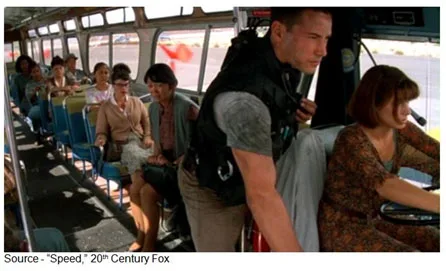
The great thing about living in Silicon Valley is that all of the car companies have advanced technology labs here so you hear about all the new gee-whiz stuff before it appears in the cars you actually buy. The tough part of that is that also means that every time you hear about something really new, really sexy, you wonder if you should wait on your next vehicle. The really bad thing about living in Silicon Valley (in addition to the cost of housing) is traffic sucks! In fact San Francisco, congestion is the second worst in the U.S, 26th worldwide. San Jose is right up there also, coming in at number 51 worldwide in congestion. But the way technology businesses are expanding here, we’ll catch up … soon. Yes, Los Angeles is worse – number 10 in overall traffic worldwide. Still, they are better than Istanbul, Mexico City, Rio de Janeiro, Moscow and a few other jam-packed cities. In San Francisco and most really large cities or “megacities,” governments are making it really challenging to own and operate a car in town. Lanes marked in red and restricted to buses, taxies, bike lanes everywhere, street projects to add subways, underground transit and alternative transportation options make driving/parking interesting.
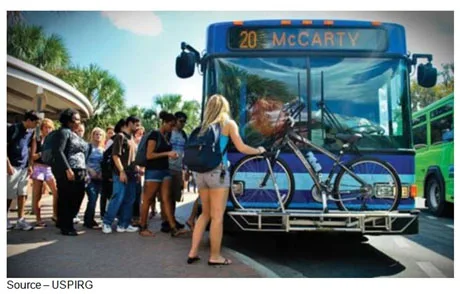 Millennial Traffic – While the auto industry is moving to deliver connected/autonomous cars for millennials, they are moving more toward alternative modes of transportation and gravitating to the city life where the car is more of a burden than a necessity.
Millennial Traffic – While the auto industry is moving to deliver connected/autonomous cars for millennials, they are moving more toward alternative modes of transportation and gravitating to the city life where the car is more of a burden than a necessity.
It’s little wonder that in most really large cities, car ownership is much lower because it costs too much to buy, drive, maintain and park them. Think it’s bad? Well, according to a BI Intellence study, Americans spend an average of 1.2 hours a day traveling between locations and 38 hours a year stuck in traffic (your mileage may vary). That’s a lot of wasted time (driving instead of texting). For the rest of us, that’s a lot of pollution (United Nations says seven million people die each year from transportation-based air pollution).
 Number 10 – People waste hours today sitting in traffic in our growing megacity environments. The autonomous car promises to relieve the tension, boredom and waste but many people are coming to believe that alternative transportation or no transportation is the real solution
Number 10 – People waste hours today sitting in traffic in our growing megacity environments. The autonomous car promises to relieve the tension, boredom and waste but many people are coming to believe that alternative transportation or no transportation is the real solution
Of course, the autonomous car is the solution! People want the stuff they have at the office and at home … in the car. Transportation manufacturers – car, truck, train and plane – are busy in the Valley and other technology centers developing in-vehicle, always-on connectivity and access that is always (you guessed it) cloud based. But they need standards, which is why:
– Apple developed the solution iOS in the Car
– Google developed its autonomous technology
– Intel is working on a variety of connected-car solutions/partners (yes, Intel inside)
– The Car Connectivity Consortium has Mirrorlink
Recently, Ford’s CEO, Mark Fields, said, “We’re at an inflection point in the auto industry. We’re thinking of ourselves as a mobility company and an auto company.” Driving that inflection is data and analytics; and obviously, Ford has a solution — Ford Smart Mobility. Transportation has had some computing capabilities for years. Probably something like a couple of Z80s (8-bit processors) taking care of one thing and letting you know as you drive along. But now, it’s pedal to the metal Tesla’s Model S was first off the line by sending real time info back to their headquarters with updates sent to the car when you’re asleep so the next morning, you have a brand new (acting) car. Everyone –Audi, Mercedes, BMW, Ford, GM, Nissan, VW (and their magic software)–is busy pouring billions into self-driving vehicle solutions. If you’re a supplier to them like Delphi, Continental, Autoliv or TRW; you’re pouring money into pet projects. If you’re Google, IBM or Cisco; you’re in the middle of it. If you’re a telco, software, media, chip or insurance company, you’re planning for your version of “my tomorrow.” The market is so big that according to BI Intelligence, in just a few years, one in four cars will be well on their way there and will be connected to the Internet,.
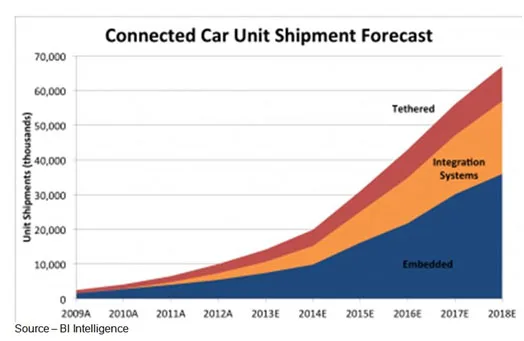 Soaring Connections – Every automotive and transportation firm is working on implementing technology that will enhance the connectivity of the vehicle enabling it to deliver faster, more reliable transportation at lower costs.
Soaring Connections – Every automotive and transportation firm is working on implementing technology that will enhance the connectivity of the vehicle enabling it to deliver faster, more reliable transportation at lower costs.
GSMA (Groupe Speciale Mobile Association) proudly proclaims that by 2020, 250M cars will be connected globally, all talking to “something.” There are only a few dents in this success story:
- People – at least millennials – aren’t that hot to drive a lot anymore
- The Internet/Web/social media have replaced face-to-face get togethers with alternatives
- Consumers want specific tools, not a complete electronic iron horse solution
- Our transportation infrastructures (globally) are deteriorating … fast
- We have an aging vehicle pool
Herbert Hoover’s U.S. presidential campaign promise doesn’t interest people today, “A chicken in every pot and a car in every garage”
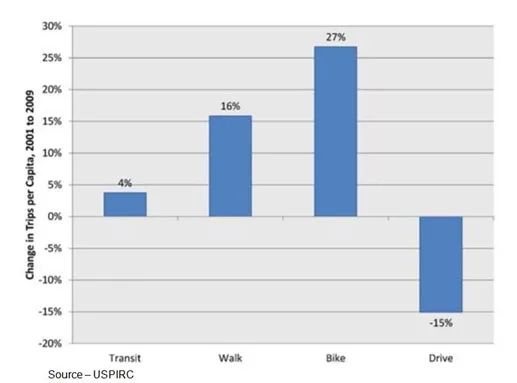 Options – Millennials (age 18-34) are finding that alternative transportation is better for the environment and their pocketbook.
Options – Millennials (age 18-34) are finding that alternative transportation is better for the environment and their pocketbook.
Millennials (born between 1983 and 2000) simply drive less than their parents and grandparents did. The average number of miles driven by 16- to 34-year-olds dropped as they took fewer trips, shorter trips and shared trips. Today, there are simply more options such as taking advantage of car-share, ride-share programs and services such as Uber, Zipcar, cabs and other modes of transportation.
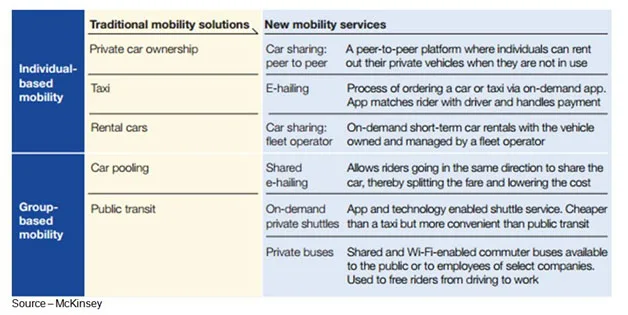 Very Good Travel – With more millennials moving into rather than out of the city, they also have a wider range of modes of transportation than their parents. The growing number of optio
Very Good Travel – With more millennials moving into rather than out of the city, they also have a wider range of modes of transportation than their parents. The growing number of optio
ns is fast, easy, economic and reliable.
McKinsey noted that a San Francisco resident would spend thousands less using alternative transportation, compared to their own car; and even more it they were willing to spend 30 percent more time traveling. Millennials are:
- Gravitating more to the city than the suburbs
- Delaying or foregoing marriage
- Delaying childbirth (a number of countries are showing negative, flat, modest childbirth)
- Burdened with college loan debt reflecting in many living at home with mom and dad
They are also using the technology they were born into by telecommuting, online web meetings, Skype and other internet-based business and personal communications solutions. And with the growing trend of order-and-instant/prompt delivery to your door, the number of shopping and parking lot tours can be dramatically reduced. But the biggest issue – even before we launch autonomous vehicles – is that the automotive industry has done perhaps too good of a job in meeting governmental requirements when it comes to improving vehicle gas mileage.
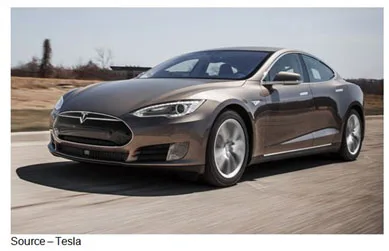 Ending Pollution – Tesla kicked off a wave of electric and hybrid vehicles that are kinder for the environment. The big problem is the roads and streets they ride on require funds for repair/maintenance which generally comes in the form of gasoline taxes. Using less/zero fuel means fewer funds.
Ending Pollution – Tesla kicked off a wave of electric and hybrid vehicles that are kinder for the environment. The big problem is the roads and streets they ride on require funds for repair/maintenance which generally comes in the form of gasoline taxes. Using less/zero fuel means fewer funds.
Tesla and every auto manufacturer have introduced electric vehicles. Then they added hybrids (using both gas and electrical power). In addition to all of the options listed above, people drive less today; and when they do drive, it is in smaller more fuel-efficient vehicles plus. Why is that bad? The Frontier Group points out that they spend less (or zero) on gasoline purchases, so there’s less tax revenue, which is where the highway construction/repair funds come in. No funds means bridges and new highway lanes aren’t built. And don’t even think about Internet-enabled roads. Heck, they can’t even be repaired for the dwindling few of us who still think driving is a lot of fun or at least a thrill as you dodge potholes and zombies behind the wheel. And if that wasn’t enough to depress your dreams about the internet-enabled and autonomous cars cruising the highway, the brutal fact is there are too damn many old cars on the road.
 Aging Transportation – While the auto industry loves parading the use of new technology as they move to connected vehicles, the average car on the road today is 11.5 years old and that age has remained relatively constant for years. The more expensive the car you buy, the longer you tend to keep it.
Aging Transportation – While the auto industry loves parading the use of new technology as they move to connected vehicles, the average car on the road today is 11.5 years old and that age has remained relatively constant for years. The more expensive the car you buy, the longer you tend to keep it.
RITA (Research and Innovative Technology Administration) and R.L. Polk Co. reported that the average age for a car in the U.S. today is 11.4 years and the average age of a light truck is 11.3 years. In other countries, the average age is 10-15 years and petrol is often even more expensive. While folks are increasingly aware of connected and autonomous cars, the industry is pushing to deliver, a global study by AT&T and Ericsson that found the features consumers wanted were:
67% — Roadside assistance
67% — Streaming music
64% — Remote start
64% — Wi-Fi hotspot
61% — Navigation with real-time traffic
If you look at the results closely they want an infotainment center that connects to their smartphone. Or maybe there will come a time when they don’t want a car in their garage at all.  They might just agree with Annie when she said, “But I’m not available to drive tomorrow. Busy.”
They might just agree with Annie when she said, “But I’m not available to drive tomorrow. Busy.”
# # #